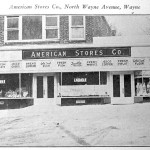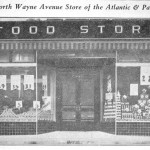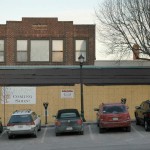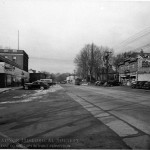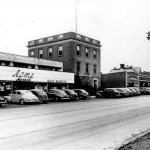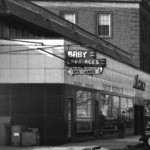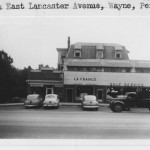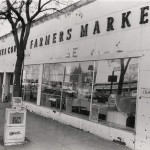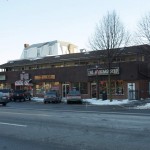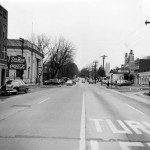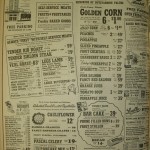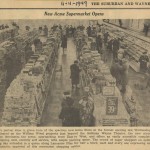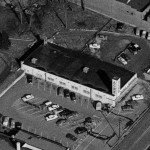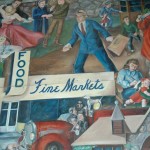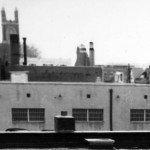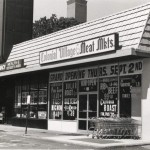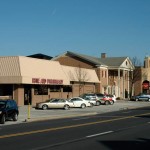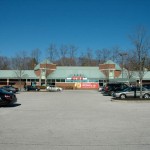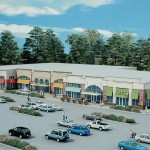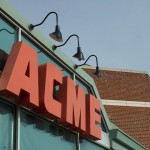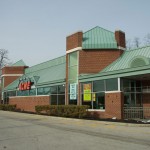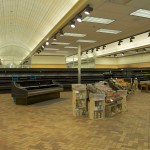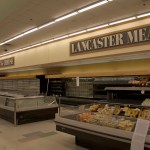By Greg Prichard
The following is an expanded version of an article that appeared in the 2011 RHS Bulletin.
Since the first half of the 20th century, Acme and American Stores Co. markets have been fixtures in downtown Wayne. As 2010 marks the 40th anniversary of the current Acme at Lancaster Avenue and N. Aberdeen Avenue, and the final full year of its operation, this is a good time to look back at the history of these markets in Wayne.
American Stores Co., 131-133 North Wayne Avenue : pre-1934-1949
The story of Acme stores in Wayne begins with that brand’s predecessor, American Stores Co., and their location at 131-133 North Wayne Avenue. It is unknown when this corner grocery store opened, but a photograph of the store appeared in the April 13, 1934 issue of the Suburban and Wayne Times. Interestingly, an A&P store opened in 1936 at 125-129 North Wayne Avenue, right next door, as photographed in the October 2, 1936 Suburban. Today each market has been divided into two storefronts; the A&P is now Troubadour Music and Wayne Vision, and the American Stores Co. is now Elegance Cafe and The Pear Tree.
American Stores used several names for their self-branded goods, such as Asco (short for American Stores Co.) for canned goods and Victor for bread. The name they chose for their butter and condensed milk is said to have originated from an automobile trip through Wayne by one of the company executives. His vehicle passed by a sign in town reading “Louella” (possibly at Louella Avenue), and was inspired to adopt the name for his company’s dairy goods. (Fry) Louella butter was a popular brand for years, continued by Acme even when most of its products were renamed “Ideal.”
The North Wayne Avenue location was a typical corner store designed for pedestrians, with quick access from the train station and the neighborhood of North Wayne. At the time the avenue was full of small stores, but it lacked adequate parking and was off of the major commercial corridor of Lancaster Avenue.
Left to right:
The American Stores Co. corner store, 131-133 North Wayne Avenue, in 1934. (Suburban & Wayne Times, April 13, 1934)
In 1936 this A&P food store opened next door to the American Stores Co. market at 125-139 North Wayne Avenue. (Suburban & Wayne Times, October 2, 1936)
131-133 North Wayne Avenue as seen in February, 2007, during renovations following the occupancy of O’Brien’s News. (Photo by the author)
Acme, 154-156 E. Lancaster Avenue : 1939-1949
In the late 1930s, the company decided to invest in supermarkets rather than corner stores, and while the North Wayne Avenue store remained open, a new Acme market (one of the first to be given that name) came to Wayne at 154-156 E. Lancaster Avenue, on the south side of that thoroughfare at the corner of Louella Avenue.
This modern, streamlined new store opened for business on October 27, 1939. (Fry) The wide new façade was likely the result of combining a row of individual storefronts, each with an apartment above. This row of stores had previously been built around an even older building, an 1880s house with mansard roof originally owned by J.C. Pinkerton. A new overhanging façade was added to the row of storefronts, faced with Acme’s new standard architecture of white panels and a blue script logo. The words “Self Service” were prominent on either side of the large centered logo. The store’s immediate neighbors were an F.W. Woolworth Co. store a few doors to the west, a Bell Telephone office building to the immediate west, and St. Mary’s Episcopal Church across Louella Avenue to the east. La France Tailors & Furriers operated underneath the east end of the Acme’s white porcelain-paneled façade.
From top left:
The 1939 Acme, at left, is seen in this view of Lancaster Avenue looking west. (Radnor Historical Society)
A close-up of the Acme store from the left photo.
The 1939 Acme as seen in the streetscape. (Internet source)
The east end of the 1939 Acme, with La France furriers and tailors at the end of the store. The third story of the Pinkerton house is visible in this view. (C.N. Agnew archive, Radnor Historical Society)
The Lancaster County Farmer’s Market, which took over the Acme building and kept its white panelled facade. It’s shown here in an undated photo, looking rather unkempt. (Suburban &Wayne Times archive, Radnor Historical Society)
The store in late 2010, split into several shops. (photo by the author)
Acme, 127 West Lancaster Avenue : 1949-1970
The 1939 Lancaster Avenue store was much larger than the North Wayne Avenue store, but only street parking was available. On November 2, 1949, a new Wayne Acme opened at 127 West Lancaster Avenue after three months of construction. The new store supplanted both the American Stores Co. on North Wayne Avenue and the 1939 store further east on the Pike, cementing Acme’s place in the growing supermarket business. (Fry) As a result the North Wayne Avenue storefront was divided into two stores, and the 154-156 E. Lancaster store became the Lancaster County Farmer’s Market. This market was a draw to downtown Wayne for many years, until it moved into a larger building on Lancaster Avenue and Eagle Road.
Built on the former front lawn of the ca. 1900 “Woodlea” estate (later the Wayne Nursing Home), the new Acme was more centrally located in town, just a few doors west of the iconic Anthony Wayne movie theater. This Acme boasted even more parking, with a lot the size of the store itself containing “free parking for hundreds of cars” according to an advertisement. The same ad called the store a “palace of foods,” and an article in the Suburban published two days after the opening pointed out the 8000 square feet for shopping and white porcelain enamel panels. The walls were peach in color, with fluorescent lighting above. “The ‘self-service’ meat counter is an innovation,” the article continued. “The shopper can pick up any cut of meat he—or more likely, she—wishes, without having to wait for the butcher to get it ready. However, if any special cut of meat is wanted, an attendant is always on duty to relay the order to the meat cutters who work out of sight of the buying public.”
The exterior of the store, 150 feet wide, was clad in white enamel panels and blue script logo. This cursive script was in contrast to the large sans-serif “ACME” letters found on the rectangular tower at the building’s southwest corner. This hard-to-miss tower was a common feature on Acme stores of the time. The Acme building was immortalized on the 1950 mural of the Radnor High School auditorium, as part of a panel depicting the Wayne of the “present.” The “Acme” name cleverly replaced with “food,” the distinctive building is easily recognizable. The mural remained in place for 57 years, long after the school’s conversion to Radnor Middle School, and was removed when the building was demolished in 2007.
From top left:
This photograph from 1951 shows the Acme store’s sign and its place in the Wayne skyline. (Radnor Police archives, Radnor Historical Society)
An advertisement from the opening week of the 1949 Wayne Acme. Advertised, among other things, is “Louella” brand butter. (Suburban & Wayne Times, November 4, 1949)
An interior view of the Wayne Acme during opening week, 1949. (Suburban & Wayne Times, November 11, 1949)
A portion of an aerial view of downtown Wayne gives a great view of the Acme store. (Radnor Historical Society)
The 1950-era mural in Radnor High/Middle School shows the Acme, made generic. This panel showed the Wayne of 1950 and its most important features. (photo by the author)
A photo taken from the roof of a nearby store shows the west facade of the Acme. (Radnor Police archives, Radnor Historical Society)
After the Acme left the location, Rite Aid and the Colonial Village Meat Market operated in the building. The large Acme tower was left and given a lighted “Rite Aid” sign. (Suburban & Wayne Times archive, Radnor Historical Society)
Today the building has been expanded to the west, and the original Acme tower has been removed. It has been a Rite Aid drug store for years, but its future is uncertain with Rite Aid’s proposal to build a new store at the northwest corner of Lancaster Avenue and Aberdeen Avenue. (photo by the author)
Acme, 311-315 East Lancaster Avenue : 1970-2011
The next Wayne Acme, located at 311-315 East Lancaster Avenue, was built in a formerly industrial portion of the town. Originally on the site had been a lumber shed, part of I. Walter Conner & Co., suppliers of feed, coal and lumber. Just to the east was the Wayne Iron Works. Both companies were supplied by sidings of the Pennsylvania Railroad, which ran along the north edge of the properties. The multiple properties along E. Lancaster Avenue to the south of I. Walter Conner were twin homes, soon to be demolished for parking spaces and a new bank building. (1930 Sanborn map of Wayne, sheet 4)
The new store, continuing the trend, had even more parking to meet the demand of the automobile’s growing influence, and a larger building that eventually housed a separate drug store on its east end. This new Acme opened on Feburary 4, 1970 (Fry). As a result, Wayne’s 1949 Acme closed after more then 20 years of operation; the building was split into two, at one time housing a Rite Aid drug store on the west side and the Colonial Village Meat Market on the east. Rite Aid would eventually take over the entire building. The large square tower remained long after the departure of Acme, painted a darker color and eventually outfitted with a lighted Rite Aid logo.
For 41 years, the 1970 Acme serviced the town, and was an important commodity to residents, especially those in neighboring apartment complexes. The store received a major renovation in the 1990s, with the addition of sloping green metal pyramidal roofs common to Acmes of the time. The adjoining drug store (which had various operators including a Rite Aid) vacated the space in the 2000s, and in 2009-10 that portion of the building was remodeled to accommodate two restaurant spaces. In 2010 Anthony’s Coal Fired Pizza, a Florida-based chain, opened one of its first stores in the Northeastern United States in one half, and a Chipotle Mexican Grill opened in the other. The Acme closed in February, 2011, and its space will be converted to a group of smaller stores and restaurants, rumored to include Five Guys, Panera Bread, Five Below and City Sports. The area will still have an Acme within close proximity; the Devon Acme, just over the Tredyffrin Township line. A Pantry Pride store until 1980, this store was heavily renovated within the last few years and is likely to remain open for years to come. Genaurdi’s in St. Davids is now the only large grocery store in Radnor Township.
From top left:
The 1970 Acme as it appeared in 2010. (photo by the author)
A sign featuring this rendering on the site shows the “Wayne Square” concept, eliminating the Acme for a row of smaller stores. This would turn the property into more of a strip mall instead of a supermarket-focused center.
The Acme’s sign in January, 2011. (photo by the author)
The front façade in January, 2011. (photo by the author)
The produce section of the Acme more than a month before closing, January, 2011. (photo by the author)
The rear of the store in January, 2011. (photo by the author)
Devon/Strafford Acme : 1980-present
Unusually close to the Wayne Acme is the Devon Acme at Tredyffrin Township’s border with Radnor. This Acme, built on the site of the former Main Line Drive-In movie theater, was originally a Pantry Pride store, and the adjoining K-Mart was originally a J.M. Fields. Both chains were operated by Food Fair, which went bankrupt and was bought by Acme in 1978. The supermarket reopened as an Acme after renovations on August 24, 1980. The K-Mart is remarkable for retaining its distinctive J.M. Fields façade to this day, despite heavy renovations to the Acme store in the 2000s.
Sources
Fry, C. Herbert. “‘The House that Quality Built’ : A Brief History of the American Stores Company.” Tredyffrin Easttown History Club History Quarterly, April 1991, 43-64.
“Acme Supermarket Opens; Has Many Aids for Shoppers.” The Suburban & Wayne Times, November 4, 1949.

